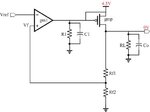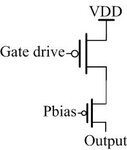tshiu
Newbie level 6
In deep-submicrometer technologies,
the thickness of gate oxide has been scaled down to increase speed.
In the meanwhile, the breakdown voltage of gate to drain or source also decrease.
Take LDO circuits for example, in shutdown mode, Vout will discharge to 0V,
but the PMOS pass element's gate and source terminals will tight to VDD (4.5V) as the figure below,
in order to turn off pass element in shutdown mode.
This will result in overstress on Vgs and Vds.
Does cascading PMOS between Vout and pass element relax this issues or there are other better moethod?

the thickness of gate oxide has been scaled down to increase speed.
In the meanwhile, the breakdown voltage of gate to drain or source also decrease.
Take LDO circuits for example, in shutdown mode, Vout will discharge to 0V,
but the PMOS pass element's gate and source terminals will tight to VDD (4.5V) as the figure below,
in order to turn off pass element in shutdown mode.
This will result in overstress on Vgs and Vds.
Does cascading PMOS between Vout and pass element relax this issues or there are other better moethod?

